|
|
|
 |

 |
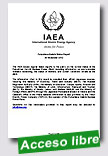 |
Fukushima Daiichi Status Report
IAEA, 30 November 2012, 15 p.
The IAEA issues regular status reports to the public on the current status of the Fukushima Daiichi Nuclear Power Plant, including information on environmental radiation monitoring, the status of workers, and current conditions on-site at the
plant. The information cited in this report is compiled from official Japanese sources, including the Ministry of Economy, Trade and Industry (METI), the Nuclear Regulation Authority (NRA), the Ministry of Education, Culture, Sports, Science and Technology (MEXT), the Ministry of Land, Infrastructure, Transport and |
Tourism (MLIT), the Ministry of Health, Labour and Welfare (MHLW) and the Ministry of Foreign Affairs (MOFA) through the Japanese Permanent Mission in Vienna and theCabinet's Office of the Prime Minister. Information is also provided by the Tokyo
Electric Power Company (TEPCO), the operator of the Fukushima Daiichi Nuclear Power Plant.
Extraído de:
http://www.iaea.org/newscenter/focus/fukushima/statusreport301112.pdf
|
 |
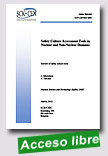 |
Safety Culture Assessment Tools in Nuclear and Non-Nuclear Domains
Belgian Nuclear Research Centre, 2012, 57 p.
Over the last decades, in many domains especially in high risk industries, the authorities paid increasing attention to safety management systems and, in particular, to safety culture. Consequently, in the applied and academic literature a huge amount of studies explored the main challenges, issues and obstacles related with safety culture. We undertake a survey of safety culture experiences in the main safety-critical industries |
such as nuclear, railways, offshore, aviation, airlines, health care, etc. We review both academic and applied literature up to the year 2011. Our results help to establish a comprehensive view on the subject, its main terminologies, existing tools, and main difficulties. The purpose of this report is to raise awareness about the current tools of safety culture assessment, both in the nuclear as well as in the non-nuclear domain. The report provides also practical recommendations about the possible use of each tool given different circumstances and different factors. We do not aim to rank the tools pointing the best one, but we highlight instead the unique features of these tools, pointing their strong and weak sides.
Extraído de: http://publications.sckcen.be/dspace/handle/10038/7763
|
 |
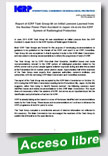 |
Report of ICRP Task Group 84 on Initial Lessons Learned from the Nuclear Power Plant Accident in Japan vis-à-vis the ICRP System of Radiological Protection
International Commission on Radiological Protection (ICRP), November 22 2012, 11 p.
In June 2011 ICRP Task Group 84 was established on Initial Lessons from the NPP Accident in Japan vis-à-vis the ICRP System of Radiological Protection.
Most ICRP Task Groups are formed for the purpose of developing recommendations or guidance to be published in the Annals of the ICRP, and report to an ICRP Committee. Task |
Group 84 was exceptional in that it reported directly to the ICRP Main Commission, and was asked to develop recommendations to inform the programme of work of ICRP.
The Task Group, led by ICRP Vice-chair Abel González, identified issues and made recommendations relevant to the ICRP system of radiological protection related to the efforts carried out to protect people against radiation exposure during and after the accident at the Fukushima Daiichi nuclear power plant in Japan. Approximately half of the members of the Task Group were experts from Japanese authorities, research institutes, and universities, with the rest being ICRP Main Commission and Committee members.
The report of the Task Group was accepted by the ICRP Main Commission on October 31, 2012 during the ICRP Main Commission meeting held in Fukushima City, Japan. As the title suggests, rather than trying to identify 'lessons learned', the following summary report identifies issues and makes recommendations to the ICRP Main Commission. The report does not necessarily reflect the opinions of ICRP, but serves as an important input into the identification and prioritisation of actions for ICRP.
ICRP is already taking action based on some of the issues identified and recommendations made by the Task Group. These issues and recommendations will continue to influence the ICRP programme of work for years to come.
The Task Group compiled a considerable amount of detailed information not reflected in this summary. The Main Commission has encouraged the members of the Task Group to publish this information in the open literature.
Extraído de:http://www.icrp.org/docs/ICRP%20TG84%20Summary%20Report.pdf
|
 |
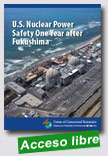 |
The designs of the Fukushima reactors closely resemble those of many U.S. reactors, and the respective emergency response procedures are comparable as well. But while most U.S. reactors may not be vulnerable to that site’s specific earthquake/tsunami sequence, they are vulnerable to other severe natural disasters. Moreover, similarly serious conditions could be created by a terrorist attack. While Fukushima had a hardened vent system, as do 23 similarly designed U.S. |
reactors, to reduce heat and pressure within the containment during an accident, this system did not work effectively because it required electrical power to operate.
As at Fukushima, most U.S. reactors also lack instrumentation that would allow operators in the control room to monitor key parameters, such as the level and temperature of the water in the spent fuel pools. In Japan and the United States alike, the possibility of an accident affecting more than one reactor at a multiunit site has simply been ignored in present accident mitigation and emergency response strategies. And while U.S. reactors, like Japanese reactors, are required to have plans to cope with a station blackout, these plans would have been useless under the conditions experienced at Fukushima.
Extraído de:
http://pbadupws.nrc.gov/docs/ML1221/ML12219A131.pdf
|
 |
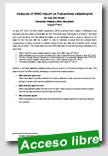 |
Analysis of WHO report on Fukushima catastrophe
International Physicians for the Prevention of Nuclear War, August 3rd 2012, 17 p.
On May 23rd, 2012, the World Health Organization (WHO) published what it called a „Preliminary dose estimation from the nuclear accident after the 2011 Great East Japan Earthquake and Tsunami“. The report aims to provide timely and authoritative information on the anticipated scale of doses in members of the public for the first year after the accident” in order to “estimate at global level the potential health |
consequences of human exposure to radiation during the first year after the Fukushima Daiichi nuclear power plant accident.” The media response to the WHO publication echoed the reassuring messages of the report itself:
· “WHO: Post-Fukushima radiation levels in Japan 'low'” (BBC, May 24th, 2012)
· “WHO: Radiation exposure near Fukushima plant within safe limits (Asahi Shimbun, May 23rd, 2012)
· “Radiation danger through Fukushima nuclear disaster less than expected” (Spiegel, May 24th,2012)
· “Most Fukushima radiation doses within norms – WHO” (Reuters, May 23rd, 2012)
· “Fukushima Radiation mostly within accepted levels” (AFP, May 23rd, 2012)
Whether or not these optimistic headlines portray the true situation in Fukushima remains to be seen. This paper analyzes the WHO report by attempting to answer three simple questions:
· What does the report say? Which information is actually contained in the report, what are its main conclusions and how do the findings compare to the numbers published by other sources?
· What does the report not say? Which important information was left out of the report, which obvious conclusions were not drawn from the raw data and where does the report show bias
. Who wrote the report? Which organizations and individuals were responsible for putting together the report and what are their motives?
Extraído de:
http://www.fukushima-disaster.de/fileadmin/user_upload/pdf/english/ippnw_analysis_WHO-report_fukushima.pdf |
 |
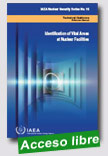 |
Identification of Vital Areas at Nuclear Facilities
IAEA Nuclear Security Series, 2012, 37 p.
This publication provides detailed guidance with regard to the identification of vital areas at nuclear facilities. It presents a structured approach to identifying the areas that contain equipment, systems and components to be protected against sabotage. The process for selection of a specific set of vital areas to be protected is based on consideration of the potential radiological consequences of sabotage, and on the design, operational and safety features of a nuclear facility. The method builds upon safety analysis to develop logic models for
|
sabotage scenarios that could cause unacceptable radiological consequences. The sabotage actions represented in the logic models are linked to the areas from which they can be accomplished. The logic models are then analysed to determine areas that should be protected to prevent these unacceptable radiological consequences. The publication is part of a set of supporting publications in the IAEA Nuclear Security Series with the aim of assisting States in the design, implementation and evaluation of their physical protection systems for nuclear material and nuclear facilities.
Extraído de:
http://www-pub.iaea.org/books/IAEABooks/8592/Identification-of-Vital-Areas-at-Nuclear-Facilities
|
 |
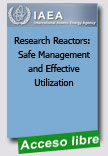
|
Research Reactors: Safe Management and Effective Utilization
IAEA Proceedings Series (CD-ROM), 2012, s. p.
Nuclear research and technology’s continuing advance relies upon research reactors (RRs) that are operated safely and reliably, adequately utilized, refurbished when necessary, provided with adequate proliferation-resistant fuel cycle services and safely decommissioned at the end of life. Today, RR operating organizations need to overcome challenges such as the productive use of facilities to justify operation and
|
maintenance costs, management of ageing facilities, the need for increased vigilance to prevent proliferation and the strain of shrinking resources, both financial and human, while fulfilling an expanding role in support of nuclear technology development.
The IAEA has a long history of addressing these challenges through its competence in providing support to improve Member States’ utilization of RRs and leading the development of safety standards and norms. Knowledge sharing is also one of the services the IAEA provides RR operating organizations by disseminating good practices for all aspects of the nuclear fuel cycle and in the planning and implementation of decommissioning. In its programmes, the IAEA promotes continued scientific research and technological development using RRs by highlighting the unique products and services these facilities can offer.
The major networking event for RR users, managers, operators and regulators is the International Conference on Research Reactors organized every four years by the IAEA. From 14 to 18 November 2011, the Conference was held for the first time in Africa, hosted by the Kingdom of Morocco through the National Centre for Energy, Science and Nuclear Techniques (CNESTEN). Following the Conferences held in Portugal in 1999, Chile in 2003, and Australia in 2007, the 2011 Conference was the largest gathering thus far.
The main objectives of this International Conference on “Research Reactors: Safe Management and Effective Utilization” were to facilitate the exchange of information on current and new RRs; provide a forum for RR users, operators, managers, regulators, designers and suppliers to share experience; exchange opinions; and discuss common challenges, options and strategies.
It is hoped that the proceedings of this Conference will serve as a valuable source of information for specialists involved in RR work and for regulatory authorities in the IAEA Member States. These proceedings contain a summary of the conference, the major findings and conclusions resulting from six technical sessions, the opening addresses, the technical papers and presentations.
Extraído de:
http://www-pub.iaea.org/MTCD/Publications/PDF/P1575_CD_web/datasets/foreword.html |
 |
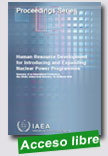 |
Human Resource Development for Introducing and Expanding Nuclear Power Programmes
IAEA Proceedings Series, 2012, 54 p
This publication is the proceedings of an international conference on human resource development for introducing and expanding nuclear power programmes. Experts from many Member States discussed the current state of human resource development in the nuclear field and addressed their concerns about possible shortages of qualified people. The conference identified several issues for consideration by national |
governments, international organizations, industry and stakeholders and highlighted the importance of sharing knowledge and expertise. One of the main goals of the conference was to provide participants with practical tools that can be used at organizational, national and international levels to develop and maintain the human resources needed to support the safe and sustainable introduction and expansion of nuclear power programmes. These proceedings include a summary, the opening and closing speeches and invited papers. The publication also includes a CD-ROM which contains the contributed papers and presentations.
Extraído de: http://www-pub.iaea.org/books/IAEABooks/8598/Human-Resource-Development-for-Introducing-and-Expanding-Nuclear-Power-Programmes-Summary-of-an-International-Conference-Abu-Dhabi-United-Arab-Emirates-14-18-March-2010
|
 |
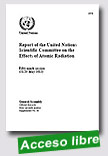 |
Report of the United Nations Scientific Committee on the Effects of Atomic Radiation Fifty-ninth session (21-25 May 2012)
UNSCEAR, 2012, 21 p.
Since the establishment of the United Nations Scientific Committee on the Effects of Atomic Radiation by the General Assembly in its resolution 913 (X) of 3 December 1955, the mandate of the Committee has been to undertake broad assessments of the sources of ionizing radiation and its effects on human health and the environment.1 In pursuit of its mandate, the Committee thoroughly reviews and evaluates
|
global and regional exposures to radiation, and also evaluates evidence of radiation-induced health effects in exposed groups, including survivors of the atomic bombings in Japan and people exposed after the reactor accident at Chernobyl. The Committee also reviews advances in the understanding of the biological mechanisms by which radiation-induced effects on human health or on non-human biota can occur. Those assessments provide the scientific foundation used, inter alia, by the relevant agencies of the United Nations system in formulating international standards for the protection of the general public and workers against ionizing radiation;2 those standards, in turn, are linked to important legal and regulatory instruments.
Extraído de: http://daccess-dds-ny.un.org/doc/UNDOC/GEN/V12/553/85/PDF/V1255385.pdf?OpenElement
|
|
|
|
|
|
|
|
|
|
|
|
